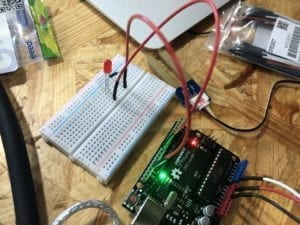For this recitation, we chose Moisture Sensor and used a LED as output to show the data. The circuit itself wasn’t complicated, but the code could be a bit tricky since we need to combine the code for AnalogInOutSerial and code for the sensor together.
 AnalogInOutSerial
AnalogInOutSerial
Building the circuit was easy. Connect the sensor’s three pins to Arduino’s ground, power and one of the analog input pin(we chose A0 here) respectively, and add a LED and a resistor to the circuit using the breadboard—then you got your circuit!
 This is the diagram of this circuit.
This is the diagram of this circuit.
we found the code for the sensor on this website: http://wiki.seeedstudio.com/Grove-Moisture_Sensor/
We added it to Arduino’s sample code AnalogInOutSerial and made a few modifications to let them work. At first, it didn’t work well, but we then found the problems and solved them.
This video shows how the circuit works. When we use damp hands to touch the sensor, it collects data and transfers it to the computer, and then lights up the LED. Later, we also tried to make the delay short and had the lightness changed according to the dampness.
I’ve had a deeper understanding of how the code works and how should we write it through this recitation, and I’m also more familiar with different kinds of sensors.
Question 1:
We intended to build a circuit that could show the data Moisture Sensor collected through the brightness of a LED. For practical use, I think farmers may find it useful. They can tell whether they need to water the plant or not by the brightness of the light as it is a symbol of the dampness of the soil. It can be a good way to save water and increase productivity as well.
Question 2:
There are many similarities between code and recipe. They both have clear goal and procedure —what dish to cook, what step should be taken first, what’s the next, etc. They use the most straightforward sentence to make the receivers understand and do their job.
Question 3:
I believe the computer has a huge impact on the way we socializing and thinking. With so many social media platforms emerging, many people prefer talking to each other online rather than face-to-face. We spend less time interacting with people in reality but online. When we run into some problems, we tend to search online and do less thinking ourselves.